Journal of Southern Medical University ›› 2025, Vol. 45 ›› Issue (9): 1889-1902.doi: 10.12122/j.issn.1673-4254.2025.09.09
Ziwei YANG1( ), Chang LÜ2, Zhu DONG1, Shulei JI1, Shenghui BI1, Xuehua ZHANG1, Xiaowu WANG1(
), Chang LÜ2, Zhu DONG1, Shulei JI1, Shenghui BI1, Xuehua ZHANG1, Xiaowu WANG1( )
)
Received:2025-04-17
Online:2025-09-20
Published:2025-09-28
Contact:
Xiaowu WANG
E-mail:a_1779874531@smu.edu.cn;xzwkwxw@smu.edu.cn
Supported by:Ziwei YANG, Chang LÜ, Zhu DONG, Shulei JI, Shenghui BI, Xuehua ZHANG, Xiaowu WANG. Rosa laevigata Michx. inhibits pulmonary arterial smooth muscle cell proliferation in hypertension by modulating the Src-AKT1 axis[J]. Journal of Southern Medical University, 2025, 45(9): 1889-1902.
Add to citation manager EndNote|Ris|BibTeX
URL: https://www.j-smu.com/EN/10.12122/j.issn.1673-4254.2025.09.09
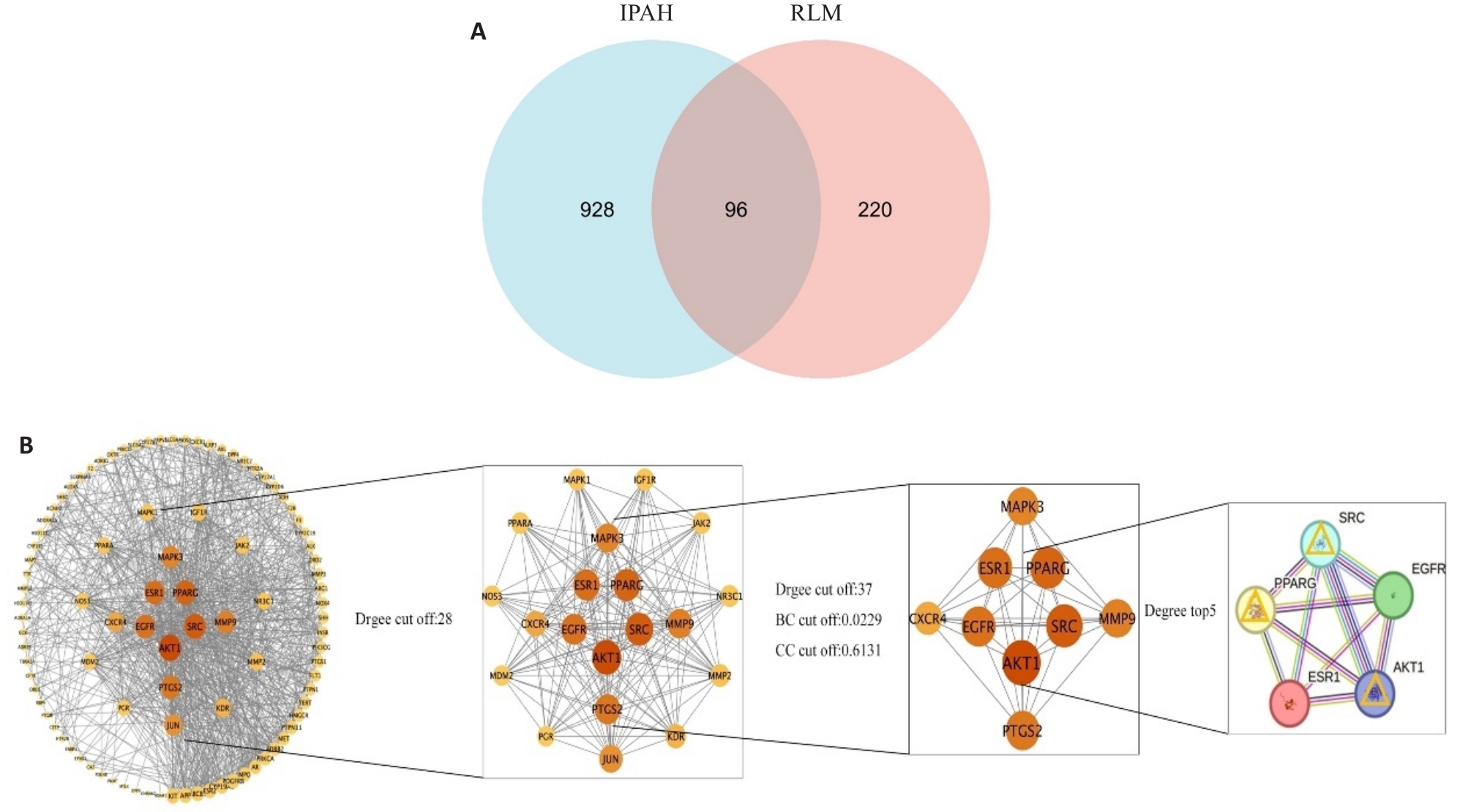
Fig.2 Target screening of RLM for treatment of pulmonary hypertension. A: Venn diagram of the intersecting targets of RLM and idiopathic pulmonary hypertension. B: Construction and screening process of the component-target network. The targets such as SRC and AKT1 show prominent network topological parameters (degree, betweenness centrality), indicating their core roles in regulating smooth muscle cell proliferation.
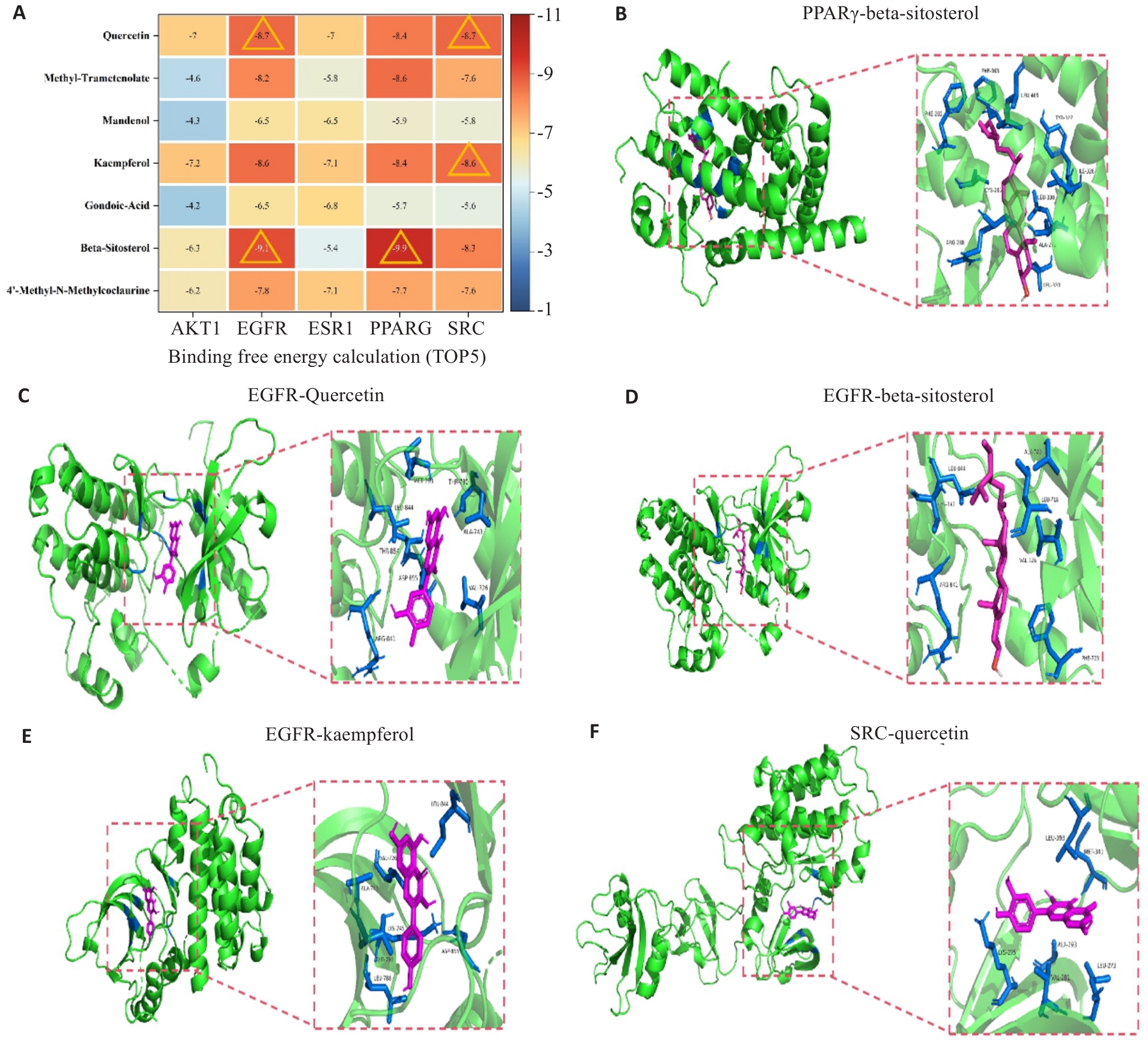
Fig.5 Molecular docking analysis of potential binding modes and reliability of interactions between the core compounds and the targets in RLM treatment of PAH. A: Calculation of the binding energy between 5 targets and 7 active components. The triangles indicate the top 5 binding energies. B: Schematic diagram of the three-dimensional structure of PPARγ-Beta-Sitosterol molecular docking result. C: EGFR-Kaempferol molecular docking result. D: EGFR-Beta-Sitosterol molecular docking result. E: EGFR-Kaempferol molecular docking result. F: SRC-Quercetin molecular docking result.
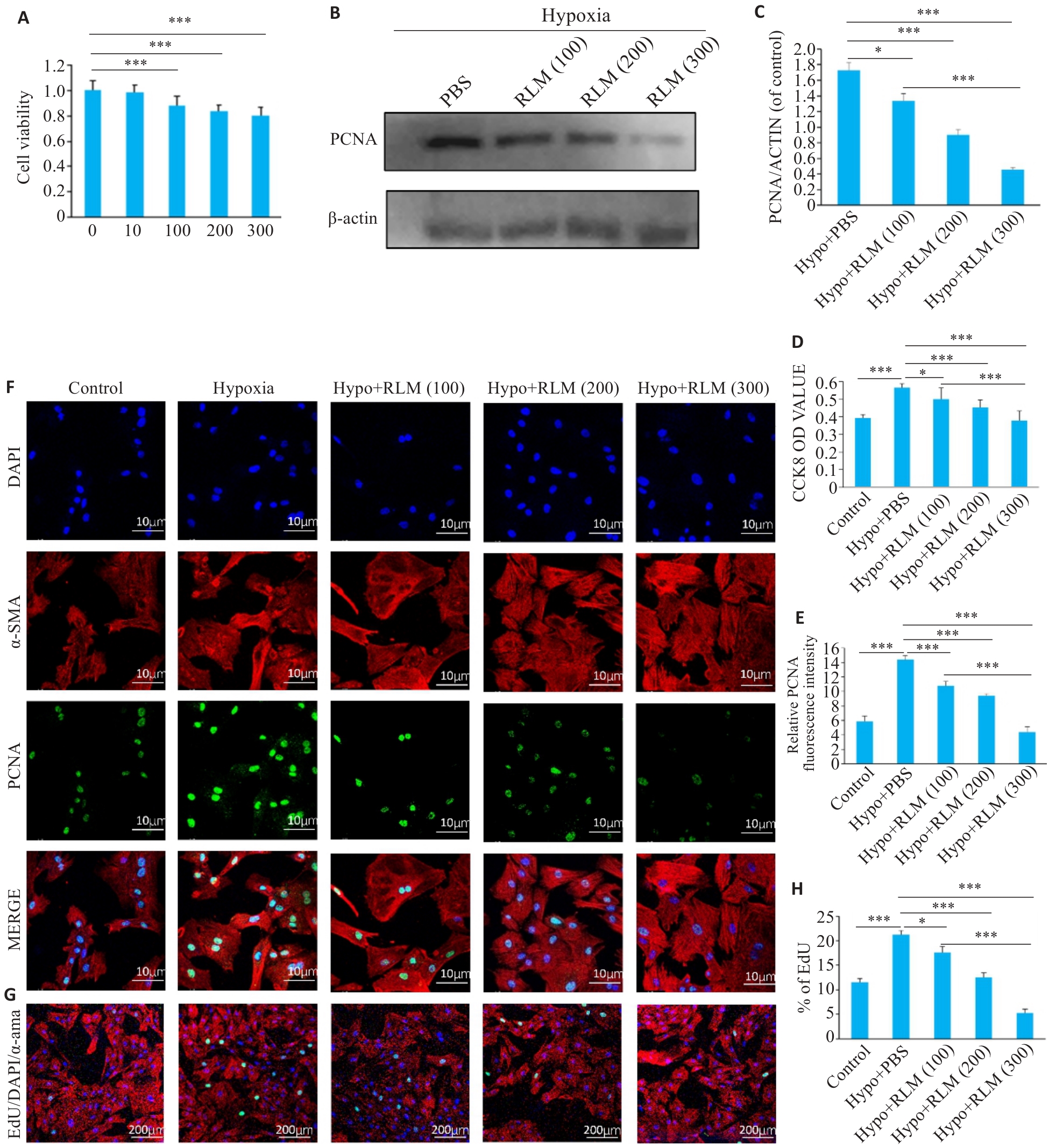
Fig.6 Inhibitory effect of RLM on proliferation of rat pulmonary arterial smooth muscle cells. A: Bar chart showing the effect of different concentrations of RLM on cell viability measured by CCK8 assay. B, C: Western blotting of PCNA in RLM-treated cells. D: Results of CCK-8 assay of RLM-treated rat pulmonary arterial smooth muscle cells under hypoxia condition. E: Quantitative analysis of PCNA expression by immunofluorescence after RLM treatment. F: Immunofluorescence assay of PCNA in RLM-treated cells (scale bar=10 μm). G:Representive image of EdU assay. H: Quantitative analysis bar graph of EdU. All data were analyzed by one-way ANOVA plus Dunnett multiple comparison test. *P<0.05, ***P<0.001.
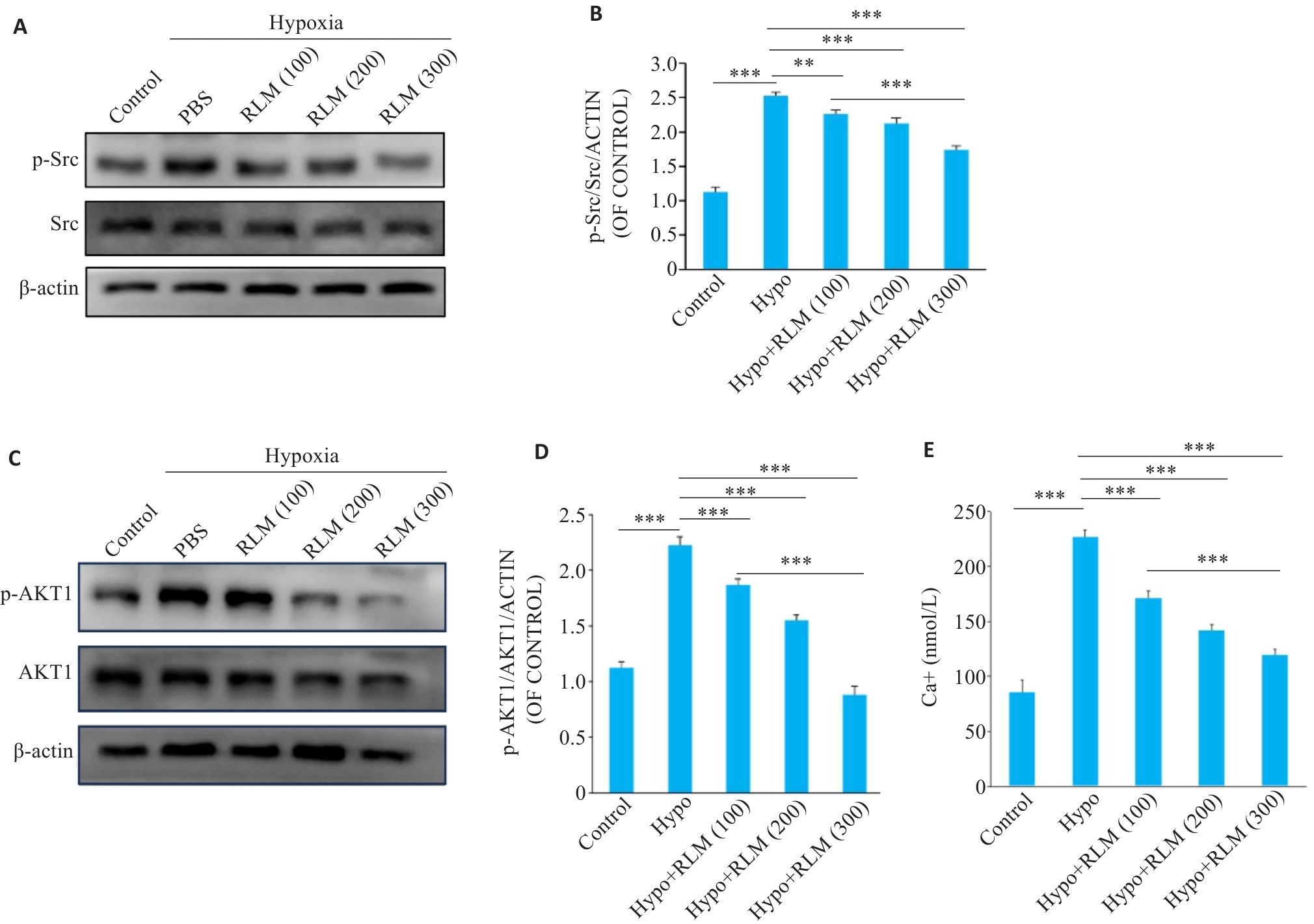
Fig.7 RLM inhibits hypoxia-induced phosphorylation of AKT1 and Src. A: Western blotting of Src and p-Src in RLM-treated cells. B: Quantitative analysis of p-Src/Src expression. C: Western blotting of AKT1 and p-AKT1 in RLM-treated cells. D: Quantitative analysis of p-AKT1/AKT1 expression. E: Calcium ion concentration measurements show a decrease in intracellular calcium levels following RLM treatment. All data were analyzed by one-way ANOVA plus Dunnett multiple comparison test. **P<0.01, ***P<0.001.
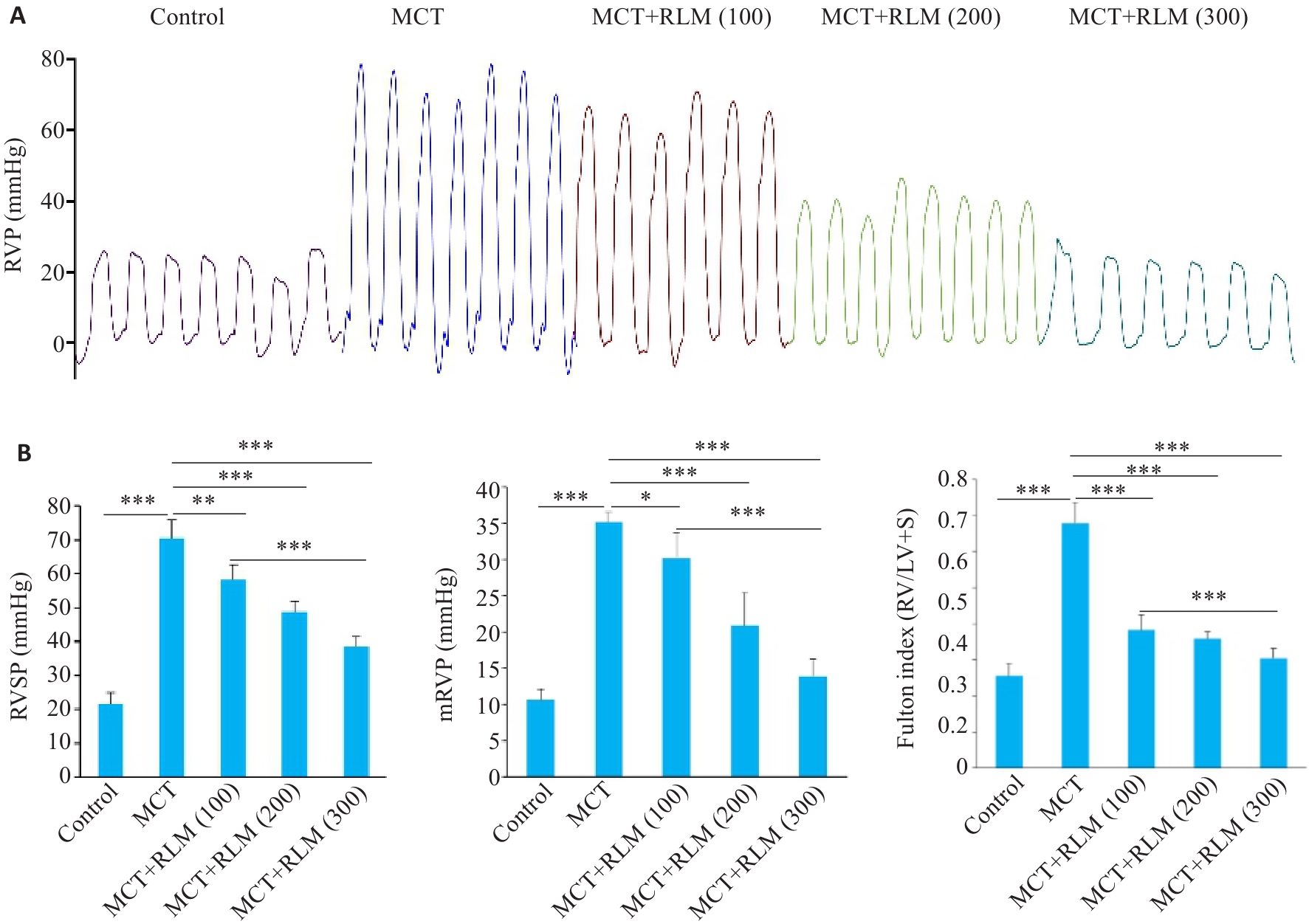
Fig.8 RLM relieves pulmonary hypertension in MCT-induced PAH rat model. A: Schematic diagram and trace of animal experiments. B: Data analysis of RVSP, mRVP and Fulton Index [RV/(LV+S)] in the 5 groups of rats. All data were analyzed by one-way ANOVA plus Dunnett multiple comparison test. *P<0.05, **P<0.01, ***P<0.001.
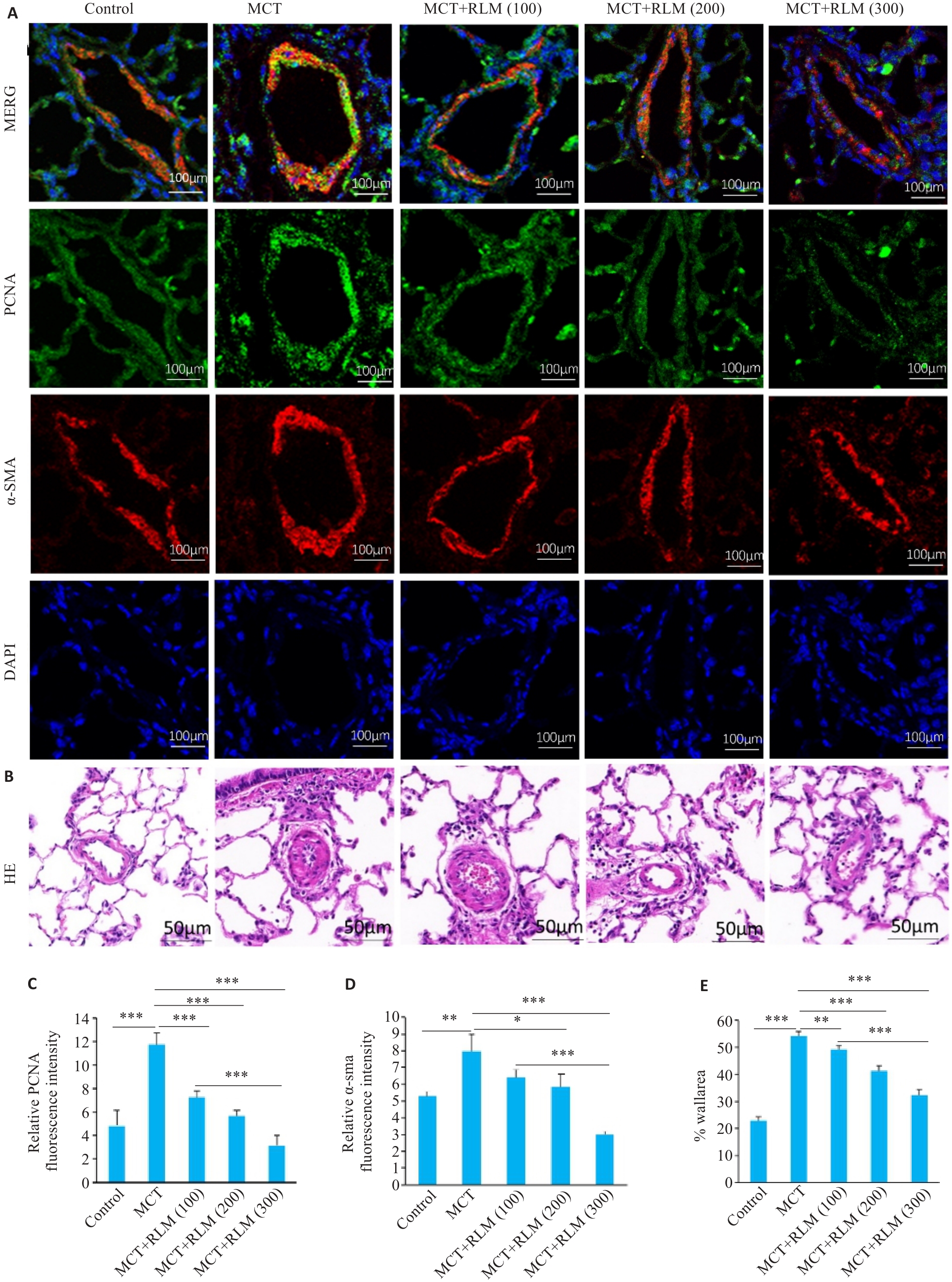
Fig.10 RLM inhibits hypoxia-induced proliferation in MCT-induced PAH rat model. A: Representative images of PCNA and α-SMA immunofluorescence post‐RLM treatment. B: Representative images of HE staining. C. Quantitative analysis of PCNA immunofluorescence post‐RLM treatment.D: Quantitative analysis of α-SMA immunofluorescence post‐RLM treatment. E. Quantitative analysis of HE staining. All data were analyzed by one-way ANOVA plus Dunnett multiple comparison test. *P<0.05, **P<0.01, ***P<0.001.
| [1] | Hassoun PM. Pulmonary arterial hypertension[J]. N Engl J Med, 2021, 385(25): 2361-76. doi:10.1056/nejmra2000348 |
| [2] | Gallardo-Vara E, Ntokou A, Dave JM, et al. Vascular pathobiology of pulmonary hypertension[J]. J Heart Lung Transplant, 2023, 42(5): 544-52. doi:10.1016/j.healun.2022.12.012 |
| [3] | Xu WL, Janocha AJ, Erzurum SC. Metabolism in pulmonary hypertension[J]. Annu Rev Physiol, 2021, 83: 551-76. doi:10.1146/annurev-physiol-031620-123956 |
| [4] | Ghofrani HA, Gomberg-Maitland M, Zhao L, et al. Mechanisms and treatment of pulmonary arterial hypertension[J]. Nat Rev Cardiol, 2025, 22(2): 105-20. doi:10.1038/s41569-024-01064-4 |
| [5] | Ruopp NF, Cockrill BA. Diagnosis and treatment of pulmonary arterial hypertension: a review[J]. JAMA, 2022, 327(14): 1379-91. doi:10.1001/jama.2022.4402 |
| [6] | Zhang JR, Ouyang X, Hou C, et al. Natural ingredients from Chinese materia Medica for pulmonary hypertension[J]. Chin J Nat Med, 2021, 19(11): 801-14. doi:10.1016/s1875-5364(21)60092-4 |
| [7] | Yu ZJ, Xiao J, Chen X, et al. Bioactivities and mechanisms of natural medicines in the management of pulmonary arterial hypertension[J]. Chin Med, 2022, 17(1): 13. doi:10.1186/s13020-022-00568-w |
| [8] | Quan XX, Huang YY, Chen L, et al. Traditional uses, phytochemical, pharmacology, quality control and modern applications of two important Chinese medicines from Rosa laevigata Michx. a review[J]. Front Pharmacol, 2022, 13: 1012265. doi:10.3389/fphar.2022.1012265 |
| [9] | Ding XR, Zheng RF, Kaderyea K, et al. Chinese herbal for mula Regan Saibisitan alleviates airway inflammation of chronic bronchitis via inhibiting the JAK2/STAT3 pathway[J]. J Ethnopharmacol, 2025, 341: 119336. doi:10.1016/j.jep.2025.119336 |
| [10] | Zhang BB, Zeng MN, Wang R, et al. Plantaginis Herba attenuates adriamycin-induced nephropathy: Molecular mechanism insights by integrated transcriptomic and experimental validation[J]. J Ethnopharmacol, 2025, 341: 119331. doi:10.1016/j.jep.2025.119331 |
| [11] | Bagchi A, Raha A, Das C, et al. Hepatoprotective efficacy of Argemone mexicana L. root in paracetamol-induced hepatotoxicity in a rat model[J]. J Ethnopharmacol, 2025, 341: 119329. doi:10.1016/j.jep.2025.119329 |
| [12] | Liang CX, Chen SJ, Liu CQ, et al. Active components unveiling and pharmacodynamic research on Valeriana jatamansi Jones for ameliorating ulcerative colitis based on pharmacokinetics and network pharmacology[J]. J Ethnopharmacol, 2025, 341: 119299. doi:10.1016/j.jep.2024.119299 |
| [13] | Ko HM, Choi SH, Kim Y, et al. Effect of Rosa laevigata on PM10-induced inflammatory response of human lung epithelial cells[J]. Evid Based Complement Alternat Med, 2020, 2020: 2893609. doi:10.1155/2020/2893609 |
| [14] | Liu XG, Liu J, Liu CF, et al. Selenium-containing polysaccharides isolated from Rosa laevigata Michx fruits exhibit excellent anti-oxidant and neuroprotective activity in vitro [J]. Int J Biol Macromol, 2022, 209(Pt A): 1222-33. doi:10.1016/j.ijbiomac.2022.04.146 |
| [15] | Zhang S, Lu BN, Han X, et al. Protection of the flavonoid fraction from Rosa laevigata Michx fruit against carbon tetrachloride-induced acute liver injury in mice[J]. Food Chem Toxicol, 2013, 55: 60-9. doi:10.1016/j.fct.2012.12.041 |
| [16] | Chen S, Wang L, Rong S, et al. Extraction, purification, chemical characterization, and in vitro hypoglycemic activity of polysaccharides derived from Rosa laevigata Michx[J]. Int J Biol Macromol, 2024, 279(Pt 1): 135116. doi:10.1016/j.ijbiomac.2024.135116 |
| [17] | Zhuang YX, Coppock JD, Haugrud AB, et al. Dichloroacetate and quercetin prevent cell proliferation, induce cell death and slow tumor growth in a mouse model of HPV-positive head and neck cancer[J]. Cancers (Basel), 2024, 16(8): 1525. doi:10.3390/cancers16081525 |
| [18] | Du L, Li CC, Qian X, et al. Quercetin inhibited mesangial cell proliferation of early diabetic nephropathy through the Hippo pathway[J]. Pharmacol Res, 2019, 146: 104320. doi:10.1016/j.phrs.2019.104320 |
| [19] | Ali F, Wang D, Cheng Y, et al. Quercetin attenuates angiotensin II-induced proliferation of vascular smooth muscle cells and p53 pathway activation in vitro and in vivo[J]. Biofactors, 2023, 49(4): 956-70. doi:10.1002/biof.1959 |
| [20] | Hou XM, Zhang MS, Qin XJ. Vasodilation of quercetin on rat renal artery and the relationship with L-type voltage-gated Ca2+ channels and protein kinase C[J]. Sheng Li Xue Bao Acta Physiol Sin, 2017, 69(6): 775-80. |
| [21] | Blaškovič D, Zižková P, Držík F, et al. Modulation of rabbit muscle sarcoplasmic reticulum Ca(2+)-ATPase activity by novel quercetin derivatives[J]. Interdiscip Toxicol, 2013, 6(1): 3-8. doi:10.2478/intox-2013-0001 |
| [22] | Baran I, Ganea C. RyR3 in situ regulation by Ca(2+) and quercetin and the RyR3-mediated Ca(2+) release flux in intact Jurkat cells[J]. Arch Biochem Biophys, 2013, 540(1/2): 145-59. doi:10.1016/j.abb.2013.10.024 |
| [23] | Yang DP, Dong WP, Yang YC, et al. Tetramethylpyrazine improves monocrotaline-induced pulmonary hypertension through the ROS/iNOS/PKG-1 axis[J]. J Healthc Eng, 2022, 2022: 1890892. doi:10.1155/2022/1890892 |
| [24] | Ma XM, Cao YQ, Yang DP, et al. Inhibition of RUNX1 slows the progression of pulmonary hypertension by targeting CBX5[J]. Biomol Biomed, 2025, 25(2): 472-81. doi:10.17305/bb.2024.10720 |
| [25] | Kazmirczak F, Vogel NT, Prisco SZ, et al. Ferroptosis-mediated inflammation promotes pulmonary hypertension[J]. Circ Res, 2024, 135(11): 1067-83. doi:10.1161/circresaha.123.324138 |
| [26] | Yung LM, Nikolic I, Paskin-Flerlage SD, et al. A selective transforming growth factor‑β ligand trap attenuates pulmonary hypertension[J]. Am J Respir Crit Care Med, 2016, 194(9): 1140-51. doi:10.1164/rccm.201510-1955oc |
| [27] | Kim K, Kim S, Moh SH, et al. Kaempferol inhibits vascular smooth muscle cell migration by modulating BMP-mediated miR-21 expression[J]. Mol Cell Biochem, 2015, 407(1/2): 143-9. doi:10.1007/s11010-015-2464-5 |
| [28] | Wang D, Ali F, Liu HX, et al. Quercetin inhibits angiotensin II-induced vascular smooth muscle cell proliferation and activation of JAK2/STAT3 pathway: a target based networking pharmacology approach[J]. Front Pharmacol, 2022, 13: 1002363. doi:10.3389/fphar.2022.1002363 |
| [29] | Wang J, Wu QB, Ding L, et al. Therapeutic effects and molecular mechanisms of bioactive compounds against respiratory diseases: traditional Chinese medicine theory and high-frequency use[J]. Front Pharmacol, 2021, 12: 734450. doi:10.3389/fphar.2021.734450 |
| [30] | Ding YY, Che DL, Li CM, et al. Quercetin inhibits Mrgprx2-induced pseudo-allergic reaction via PLCγ-IP3R related Ca2+ fluctuations[J]. Int Immunopharmacol, 2019, 66: 185-97. doi:10.1016/j.intimp.2018.11.025 |
| [31] | Zhou C, Townsley MI, Alexeyev M, et al. Endothelial hyperpermeability in severe pulmonary arterial hypertension: role of store-operated calcium entry[J]. Am J Physiol Lung Cell Mol Physiol, 2016, 311(3): L560-9. doi:10.1152/ajplung.00057.2016 |
| [32] | Wang J, Xu CY, Zheng QY, et al. Orai1, 2, 3 and STIM1 promote store-operated calcium entry in pulmonary arterial smooth muscle cells[J]. Cell Death Discov, 2017, 3: 17074. doi:10.1038/cddiscovery.2017.74 |
| [33] | Weatherald J, Hemnes AR, Maron BA, et al. Phenotypes in pulmonary hypertension[J]. Eur Respir J, 2024, 64(3): 2301633. doi:10.1183/13993003.01633-2023 |
| [34] | Egom EE. Pulmonary arterial hypertension due to NPR-C mutation: a novel paradigm for normal and pathologic remodeling[J]? Int J Mol Sci, 2019, 20(12): 3063. doi:10.3390/ijms20123063 |
| [35] | Wang J, Niu YQ, Luo LJ, et al. Decoding CeRNA regulatory network in the pulmonary artery of hypoxia-induced pulmonary hypertension (HPH) rat model[J]. Cell Biosci, 2022, 12(1): 27. doi:10.1186/s13578-022-00762-1 |
| [36] | Klouda T, Tsikis ST, Hirsch TI, et al. Smooth muscle Cxcl12 contributions to vascular remodeling in flow and hypoxia-induced pulmonary hypertension[J]. J Biol Chem, 2025, 301(6): 110207. doi:10.1016/j.jbc.2025.110207 |
| [37] | Huang HJ, Lin DH, Hu L, et al. RNA binding protein quaking promotes hypoxia-induced smooth muscle reprogramming in pulmonary hypertension[J]. Am J Respir Cell Mol Biol, 2023, 69(2): 159-71. doi:10.1165/rcmb.2022-0349oc |
| [38] | Tang LX, Cai Q, Wang X, et al. Canagliflozin ameliorates hypobaric hypoxia-induced pulmonary arterial hypertension by inhibiting pulmonary arterial smooth muscle cell proliferation[J]. Clin Exp Hypertens, 2023, 45(1): 2278205. doi:10.1080/10641963.2023.2278205 |
| [39] | Wang LL, Moonen JR, Cao AQ, et al. Dysregulated smooth muscle cell BMPR2-ARRB2 axis causes pulmonary hypertension[J]. Circ Res, 2023, 132(5): 545-64. doi:10.1161/circresaha.121.320541 |
| [40] | Ji L, Su SS, Xin MY, et al. Luteolin ameliorates hypoxia-induced pulmonary hypertension via regulating HIF-2α-Arg-NO axis and PI3K-AKT-ENOS-NO signaling pathway[J]. Phytomedicine, 2022, 104: 154329. doi:10.1016/j.phymed.2022.154329 |
| [41] | Wang J, Xuan B, Song BM, et al. MTMR7 attenuates the proliferation and migration of pulmonary arterial smooth muscle cells in pulmonary hypertension by suppressing ERK/STAT3 signaling[J]. Mol Cell Biochem, 2025, 480(6): 3799-812. doi:10.1007/s11010-025-05217-y |
| [42] | Huang L, Li HY, Huang SQ, et al. Notopterol attenuates monocrotaline-induced pulmonary arterial hypertension in rat[J]. Front Cardiovasc Med, 2022, 9: 859422. doi:10.3389/fcvm.2022.859422 |
| [43] | Manning BD, Toker A. AKT/PKB signaling: navigating the network[J]. Cell, 2017, 169(3): 381-405. doi:10.1016/j.cell.2017.04.001 |
| [44] | Luo J, Zeng BL, Tao CF, et al. ClpP regulates breast cancer cell proliferation, invasion and apoptosis by modulating the Src/PI3K/Akt signaling pathway[J]. PeerJ, 2020, 8: e8754. doi:10.7717/peerj.8754 |
| [45] | Cai BR, Yang L, Jung YD, et al. PTEN: an emerging potential target for therapeutic intervention in respiratory diseases[J]. Oxid Med Cell Longev, 2022, 2022: 4512503. doi:10.1155/2022/4512503 |
| [46] | Sala V, Margaria JP, Murabito A, et al. Therapeutic targeting of PDEs and PI3K in heart failure with preserved ejection fraction (HFpEF)[J]. Curr Heart Fail Rep, 2017, 14(3): 187-96. doi:10.1007/s11897-017-0331-2 |
| [47] | Mirhadi E, Roufogalis BD, Banach M, et al. Resveratrol: Mechanistic and therapeutic perspectives in pulmonary arterial hypertension[J]. Pharmacol Res, 2021, 163: 105287. doi:10.1016/j.phrs.2020.105287 |
| [48] | Hsieh MW, Wang WT, Yeh JL, et al. The potential application and promising role of targeted therapy in pulmonary arterial hypertension[J]. Biomedicines, 2022, 10(6): 1415. doi:10.3390/biomedicines10061415 |
| [49] | Kim OH, Choi YW, Park JH, et al. Fluid shear stress facilitates prostate cancer metastasis through Piezo1-Src-YAP axis[J]. Life Sci, 2022, 308: 120936. doi:10.1016/j.lfs.2022.120936 |
| [50] | Lan YN, Lu J, Zhang SH, et al. Piezo1-mediated mechano-transduction contributes to disturbed flow-induced atherosclerotic endothelial inflammation[J]. J Am Heart Assoc, 2024, 13(21): e035558. doi:10.1161/JAHA.123.035558 |
| [51] | Zhang S, Wang J, Qi XM, et al. Plasminogen activator Inhibitor-2 inhibits pulmonary arterial smooth muscle cell proliferation in pulmonary arterial hypertension via PI3K/Akt and ERK signaling[J]. Exp Cell Res, 2021, 398(1): 112392. doi:10.1016/j.yexcr.2020.112392 |
| [1] | Qin HU, Hua JIN. Qingshen Granules improves renal function of patients with chronic kidney disease damp-heat syndrome by activating the miR-23b and Nrf2 pathway [J]. Journal of Southern Medical University, 2025, 45(9): 1867-1879. |
| [2] | Xinyuan CHEN, Chengting WU, Ruidi LI, Xueqin PAN, Yaodan ZHANG, Junyu TAO, Caizhi LIN. Shuangshu Decoction inhibits growth of gastric cancer cell xenografts by promoting cell ferroptosis via the P53/SLC7A11/GPX4 axis [J]. Journal of Southern Medical University, 2025, 45(7): 1363-1371. |
| [3] | Liming WANG, Hongrui CHEN, Yan DU, Peng ZHAO, Yujie WANG, Yange TIAN, Xinguang LIU, Jiansheng LI. Yiqi Zishen Formula ameliorates inflammation in mice with chronic obstructive pulmonary disease by inhibiting the PI3K/Akt/NF-κB signaling pathway [J]. Journal of Southern Medical University, 2025, 45(7): 1409-1422. |
| [4] | Yinfu ZHU, Yiran LI, Yi WANG, Yinger HUANG, Kunxiang GONG, Wenbo HAO, Lingling SUN. Therapeutic mechanism of hederagenin, an active component in Guizhi Fuling Pellets, against cervical cancer in nude mice [J]. Journal of Southern Medical University, 2025, 45(7): 1423-1433. |
| [5] | Lijun HE, Xiaofei CHEN, Chenxin YAN, Lin SHI. Inhibitory effect of Fuzheng Huaji Decoction against non-small cell lung cancer cells in vitro and the possible molecular mechanism [J]. Journal of Southern Medical University, 2025, 45(6): 1143-1152. |
| [6] | Guoyong LI, Renling LI, Yiting LIU, Hongxia KE, Jing LI, Xinhua WANG. Therapeutic mechanism of Arctium lappa extract for post-viral pneumonia pulmonary fibrosis: a metabolomics, network pharmacology analysis and experimental verification [J]. Journal of Southern Medical University, 2025, 45(6): 1185-1199. |
| [7] | Liping GUAN, Yan YAN, Xinyi LU, Zhifeng LI, Hui GAO, Dong CAO, Chenxi HOU, Jingyu ZENG, Xinyi LI, Yang ZHAO, Junjie WANG, Huilong FANG. Compound Centella asiatica formula alleviates Schistosoma japonicum-induced liver fibrosis in mice by inhibiting the inflammation-fibrosis cascade via regulating the TLR4/MyD88 pathway [J]. Journal of Southern Medical University, 2025, 45(6): 1307-1316. |
| [8] | Peipei TANG, Yong TAN, Yanyun YIN, Xiaowei NIE, Jingyu HUANG, Wenting ZUO, Yuling LI. Tiaozhou Ziyin recipe for treatment of premature ovarian insufficiency: efficacy, safety and mechanism [J]. Journal of Southern Medical University, 2025, 45(5): 929-941. |
| [9] | Xiaotao LIANG, Yifan XIONG, Xueqi LIU, Xiaoshan LIANG, Xiaoyu ZHU, Wei XIE. Huoxue Shufeng Granule alleviates central sensitization in chronic migraine mice via TLR4/NF-κB inflammatory pathway [J]. Journal of Southern Medical University, 2025, 45(5): 986-994. |
| [10] | Niandong RAN, Jie LIU, Jian XU, Yongping ZHANG, Jiangtao GUO. n-butanol fraction of ethanol extract of Periploca forrestii Schltr.: its active components, targets and pathways for treating Alcheimer's disease in rats [J]. Journal of Southern Medical University, 2025, 45(4): 785-798. |
| [11] | Haonan¹ XU, Fang³ ZHANG, Yuying² HUANG, Qisheng⁴ YAO, Yueqin⁴ GUAN, Hao CHEN. Thesium chinense Turcz. alleviates antibiotic-associated diarrhea in mice by modulating gut microbiota structure and regulating the EGFR/PI3K/Akt signaling pathway [J]. Journal of Southern Medical University, 2025, 45(2): 285-295. |
| [12] | Junjie GAO, Kai YE, Jing WU. Quercetin inhibits proliferation and migration of clear cell renal cell carcinoma cells by regulating TP53 gene [J]. Journal of Southern Medical University, 2025, 45(2): 313-321. |
| [13] | Ying LIU, Borui LI, Yongcai LI, Lubo CHANG, Jiao WANG, Lin YANG, Yonggang YAN, Kai QV, Jiping LIU, Gang ZHANG, Xia SHEN. Jiawei Xiaoyao Pills improves depression-like behavior in rats by regulating neurotransmitters, inhibiting inflammation and oxidation and modulating intestinal flora [J]. Journal of Southern Medical University, 2025, 45(2): 347-358. |
| [14] | Qiao CHU, Xiaona WANG, Jiaying XU, Huilin PENG, Yulin ZHAO, Jing ZHANG, Guoyu LU, Kai WANG. Pulsatilla saponin D inhibits invasion and metastasis of triple-negative breast cancer cells through multiple targets and pathways [J]. Journal of Southern Medical University, 2025, 45(1): 150-161. |
| [15] | Xiupeng LONG, Shun TAO, Shen YANG, Suyun LI, Libing RAO, Li LI, Zhe ZHANG. Quercetin improves heart failure by inhibiting cardiomyocyte apoptosis via suppressing the MAPK signaling pathway [J]. Journal of Southern Medical University, 2025, 45(1): 187-196. |
| Viewed | ||||||
|
Full text |
|
|||||
|
Abstract |
|
|||||